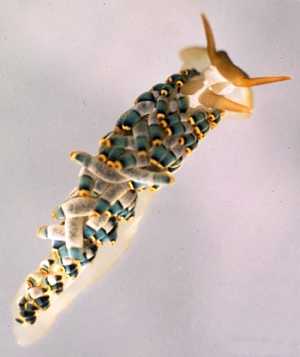
Cuthona yamasui
Hamatani, 1993
Order: NUDIBRANCHIA
Suborder: AEOLIDINA
Family: Tergipedidae
DISTRIBUTION
Tropical Indo-West Pacific.
PHOTO
UPPER: Wonga Beach, N. of Mossman, Queensland, Australia, January 1974. AM C94083. Photo: I. Loch.
LOWER LEFT: Broadhurst Reef, 12-15m, Townsville, Queensland, 18 Nov 1974, AM C96580. Photo: I. Loch.
LOWER RIGHT: SEM Photo of radula of Wonga Beach specimen. Photo: G. Avern.
This species seems to be quite variable in colour, in particular, the head, rhinophores and oral tentacles appear to range in colour from a translucent orange to a dark translucent blue-black. The second point of variation concerns the areas with opaque white pigementation. In some animals the translucent body wall has scattered patches of opaque white while in other specimens there is a solid colouring of white.
Hamatani's description was based on an animal from Okinawa in which the head was orange and the white pigmentation consisted of scattered, irregular shaped and sized white patches. He described it as having a ground colour which was translucent or colourless or light orange-yellow. The head, oral tentacles and rhinophores were orange red, and over the dorsal and lateral surfaces of the body behind the rhinophores there were many [irregular] opaque white patches. There was a prominent white [median] band on the head beween the rhinophores which extended anteriorly to the lower halves of the oral tentacles and laterally to the outer sides of the rhinophores. The tips of the oral tentacles and rhinophores were white. The upper portion of the cerata were tinged with reddish orange and there was a small white ring below the protruded tip of each ceras. The lower portion of the ceras was covered with clusters of opaque white dots. It was found feeding on the hydroid Aglaophenia cupressina.
The two animals illustrated here represent two extremes of the colour pattern. Other photos in messages from Erwin Koehler and Bernard Picton show other colour variations. The radular morphology illustrated here is identical to Hamatani's dscription.
Note: This species was previously named Cuthona sp. 1 on the Forum.
Reference:
• Hamatani, I (1993) A new cuthonid species (Nudibranchia, Aeolidacea), Cuthona yamasui n.sp., from Okinawa, Southwestern Japan. Venus, The Japanese Journal of Malacology, 52(2): 127-133. (Figs 1-3)
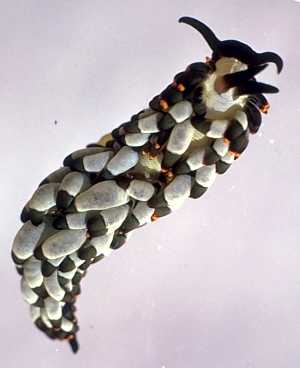
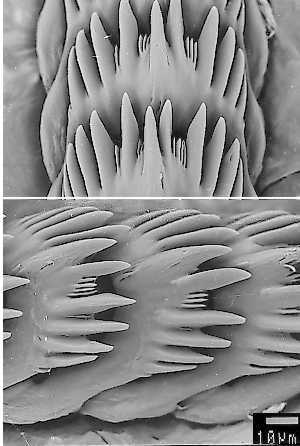
Rudman, W.B., 2002 (March 13) Cuthona yamasui Hamatani, 1993. [In] Sea Slug Forum. Australian Museum, Sydney. Available from http://www.seaslugforum.net/find/cuthyama
Related messages
Trinchesia yamasui from Gulf of Kachchh
April 12, 2010
From: Vinod Gajjar
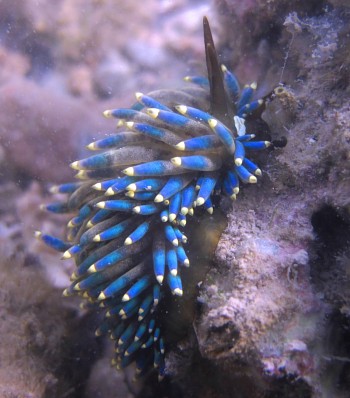
Dear Dr. Bill,
I got this specimen from Gulf of Kachchh [Gulf of Kutch], feeding on hydroid. I counted 4 to 5.
Locality: Coastal reef, 20cm, Gujarat, India, Gulf of Kachchh, NW India, 10 February 2010, intertidal rockpool. Length: 21 mm. Photographer: Vinod Gajjar.
Wishes
Vinod
dparasharya@gmail.com
Gajjar V. S., 2010 (Apr 12) Trinchesia yamasui from Gulf of Kachchh. [Message in] Sea Slug Forum. Australian Museum, Sydney. Available from http://www.seaslugforum.net/find/23412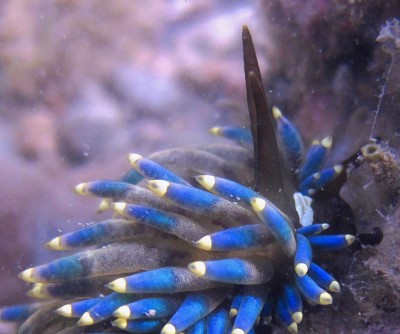
Dear Vinod,
Thanks for filling another gap in its known distribution. It is clearly widespread throughout the tropical West Pacific and Indian Oceans
Best wishes,
Bill Rudman
Cuthona yamasui aggregation
August 19, 2009
From: Brian Mayes
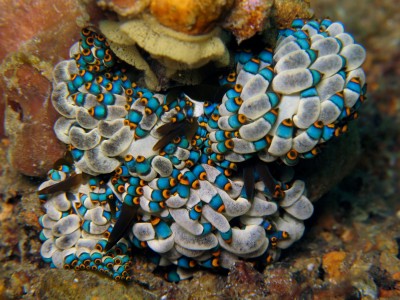
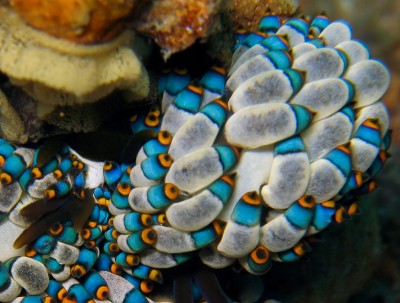
Concerning message #11017:
Dear Bill,
I'm interested to hear what you think about this aggregation of Cuthona yamasui or Trinchesia yamasui as another well known forum seems to call them now. Normally aggregations like this seem to collect around a food source, but as far as I know C. yamasui eats only hydroids and it doesn't look like they are grouped around hydroids in the photo. At the top of the photo there is a an egg ring so perhaps this is some sort of mass mating or egg laying. By the way, if you happen to work out how many are in the photo, please let me know. :-)
Locality: Secret Bay, Mainit, Anilao, 14 metres, Batangas, Philippines, Philippines Sea, 5 February 2009, Sandy sloping bay. Length: 45 mm. Photographer: Brian Mayes.
Kind Regards
Brian Mayes
brian.r.mayes@gmail.com
Mayes, B.R., 2009 (Aug 19) Cuthona yamasui aggregation. [Message in] Sea Slug Forum. Australian Museum, Sydney. Available from http://www.seaslugforum.net/find/22548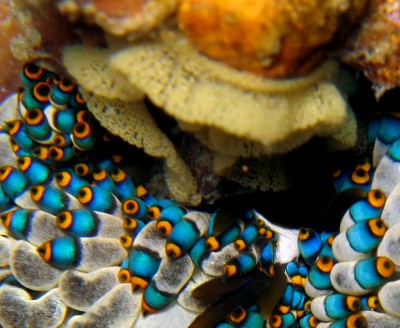
Dear Brian,
I could be wrong but I suspect the egg ribbon was produced by some dorid nudibranch rather than an aeolid. There are a few aeolid species, like Phestilla melanobrachia, with similarly shaped egg ribbons, but it is unusual. If the eggs do belong to the Cuthona I still can't say whether they aggregated for mating or whether they mated because they had aggregated for some other reason. Some large aeolids, especially the coral eaters, tend to aggregate in crevices during the day, or under the coral colony [hiding from predators] and emerge at night to feed. Perhaps your animals were doing there best to hide during the day. The hydroids this species apparently eats have quite fearsome stings, so perhaps they are quite well protected when they are on a big healthy hydroid colony. Perhaps they have eaten out such are hydroid colony and have lost their protection? - don't quote me on that - just throwing around a few ideas.
Best wishes,
Bill Rudman
Cuthona yamasui? from Indonesia
August 29, 2008
From: Linda Ianniello
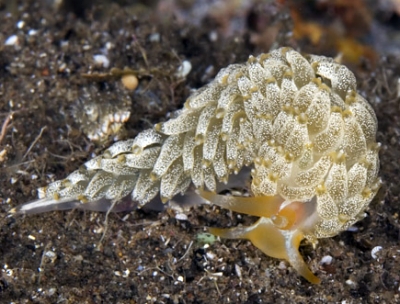
Dear Bill
I have no clue what this is. It looks pretty straightforward, but I can't find anything like it in all my references .... sure would appreciate your help!
Locality: Sambousa Island, Sangean, Black Magic, 40 feet, Indonesia, 5 September 2006, Coral reef. Photographer: Linda Ianniello.
Regards,
Linda I.
lindai1@bellsouth.net
Ianniello, L.M., 2008 (Aug 29) Cuthona yamasui? from Indonesia. [Message in] Sea Slug Forum. Australian Museum, Sydney. Available from http://www.seaslugforum.net/find/18491Dear Linda,
I may be quite wrong but I suspect this is a colour form of Cuthona yamasui. I have have identified an earlier find as possibly that species [message #21277] but of course we would need to know something about its anatomy to be sure
Best wishes,
Bill Rudman
Colour form of Cuthona yamasui
February 12, 2008
From: Mirjam Broos
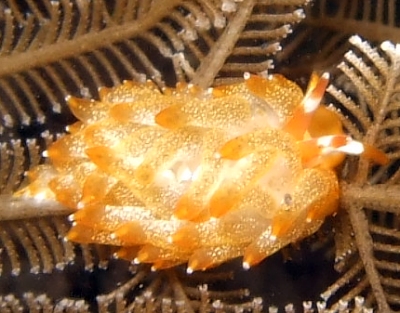
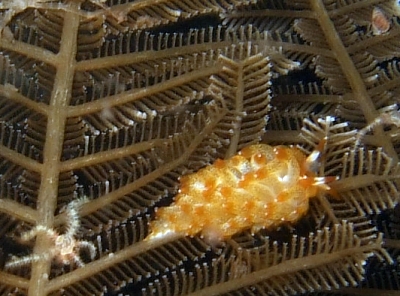
He Bill,
We found this nudi during a nightdive. I can't find it in my books. What did we find?
Locality: Coral garden, Tulemben, 10 metres, Bali, Indonesia, Indian ocean, 02 april 2007, nightdive. Photographer: Geert Prast.
greetings,
Mirjam
mirjam.broos@planet.nl
Broos, M., 2008 (Feb 12) Colour form of Cuthona yamasui. [Message in] Sea Slug Forum. Australian Museum, Sydney. Available from http://www.seaslugforum.net/find/21277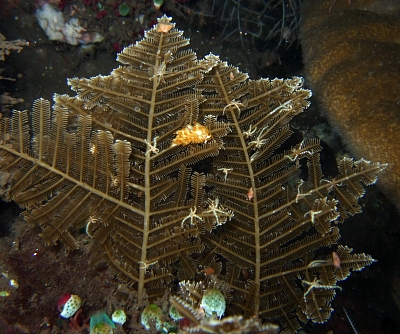
Dear Mirjam,
I can't be 100% sure but I suspect this is a colour form of Cuthona yamasui. That species has quite a range of colour variation and this could be a particularly orange form. C. yamasui is usually found feeding on stinging hydroids of the genus Aglaophenia, and I wouldn't be surprised if the hydroid colony in your photo is in the same or a related genus.
Best wishes,
Bill Rudman
Cuthona yamasui from the Philippines
July 7, 2007
From: Colin Teo
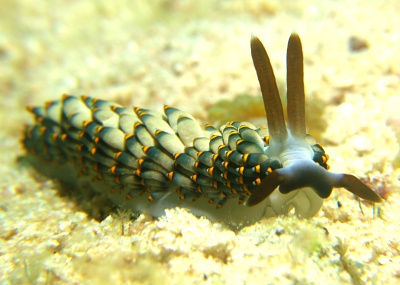
Hi,
I saw this in the Philippines and not sure what this is. Can you help to identify?
Locality: Malapascua, 8m, Philippines, 22 February 2007. Length: about 4cm I think. Photographer: Colin Teo.
Thanks.
Colin Teo
colin_teo@yahoo.com
Teo, C., 2007 (Jul 7) Cuthona yamasui from the Philippines. [Message in] Sea Slug Forum. Australian Museum, Sydney. Available from http://www.seaslugforum.net/find/19639Dear Colin,
This is Cuthona yamasui.
Best wishes,
Bill Rudman
Cuthona yamasui from Queensland
March 21, 2007
From: Paul Osmond
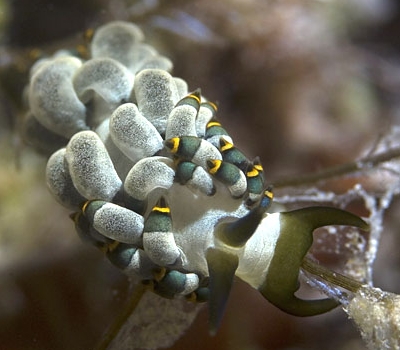
Hi Bill,
I found this little nudibranch on a hydroid on a night dive on a reef out near the Cod Hole in north Queensland, Australia. He was very small - probably under 1cm in size.
Locality: Great Barrier Reef, Near Cod Hole, 20m, Queensland, Australia, Pacific, 03 January 2007, Coral Reef Heads. Length: 10mm. Photographer: Paul T. Osmond.
It looks to be very similar to the nudibranch identified as Cuthona yamasui in a couple of other messages.
I love the coloration on this one!
Yours,
Paul
marriard@deepseaimages.com
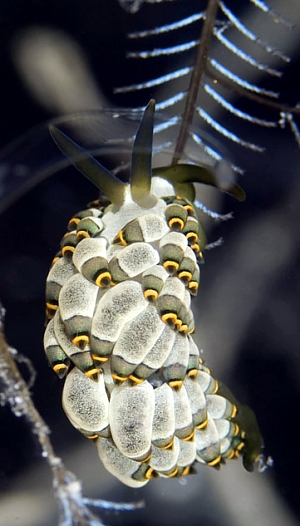
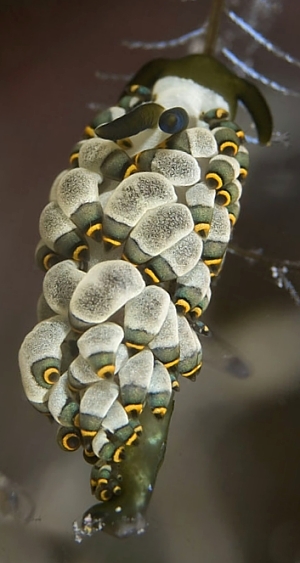
Dear Paul,
Yes this is Cuthona yamasui.
Best wishes,
Bill Rudman
Cuthona yamasui from the Andaman Sea, Thailand
March 5, 2007
From: Vie Panyarachun
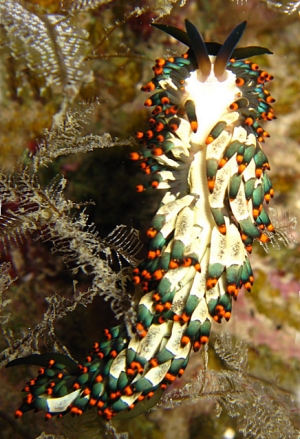
Dear Dr. Rudman,
I photographed this aeolid (?) during a night dive. Would like a species ID please. Thank you.
Locality: South Surin, Surin Islands National Park, approx. 12 msw, Thailand, Andaman Sea, 21 February 2007. Photographer: Vie Panyarachun.
Sincerely,
Vie Panyarachun
vpanyarachun@hotmail.com
Panyarachun, V., 2007 (Mar 5) Cuthona yamasui from the Andaman Sea, Thailand. [Message in] Sea Slug Forum. Australian Museum, Sydney. Available from http://www.seaslugforum.net/find/19546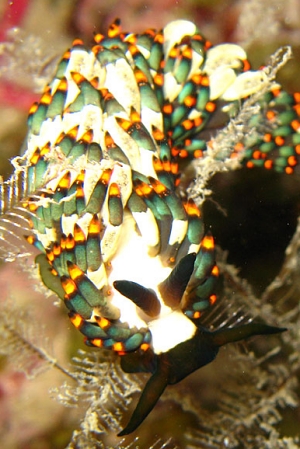
Dear Vie,
This is Cuthona yamasui. It seems to be a specialised feeder on this species hydroid, Aglaophenia cupressina
Best wishes,
Bill Rudman
Cuthona yamasui? from Nth Sulawesi
April 10, 2006
From: Roberto Sozzani
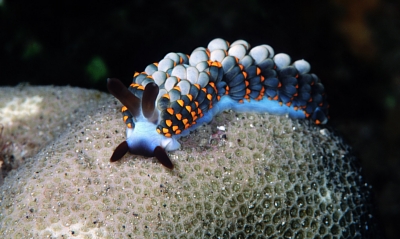
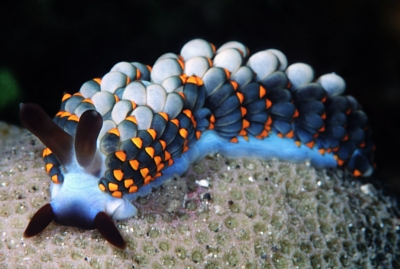
Dear Bill,
Is this Cuthona yamasui? I found it at the beginning of a dive on top of a small round block of coral and I was surprised to see him at the same place at the end of the dive, after at least one hour.
Locality: Lembeh Streit - North Sulawesi, 8 metres, Indonesia, Pacific Ocean, November 2003, Muddy with some coral heads. Length: 5 cm. Photographer: Roberto Sozzani.
Best wishes
Roberto Sozzani
roberto.sozzani@fastwebnet.it
Sozzani, R., 2006 (Apr 10) Cuthona yamasui? from Nth Sulawesi. [Message in] Sea Slug Forum. Australian Museum, Sydney. Available from http://www.seaslugforum.net/find/16277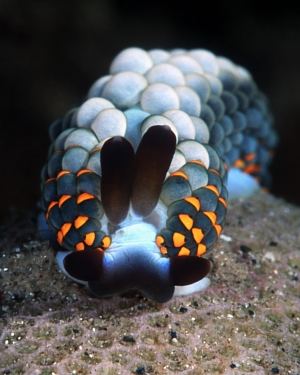
Dear Roberto,
Yes this is C. yamasui, but it is certainly out of place sitting on a live coral colony, probably a species of Porites. I suspect this animal has been placed on this coral head by another diver who perhaps brought it back to show his friends, and then he/she carefully 'put it back' so it wouldn't come to harm. Unfortunately unless you put animals back in the right place you are usually condemning them to death.
If you look at the way all the cerata are contracted, as are the rhinophores and oral tentacles, this is not a happy animal. I would say it is being stung or is in contact with noxious chemicals excreted by the coral colony. Because of that it won't move. That's why I suspect it can't have crawled onto the colony itself.
It reminds me of work I did on the coral-feeding species of Phestilla. When I was trying to see just how choosy the Porites-feeding Phestilla lugubris was, I noticed that some colonies of what was thought to be the common local species of Porites were slightly different in colour and colony shape than the rest, and I never found Phestilla on them in the field. So I brought about 50 small colonies - some 'normal' some not - back into the lab and one test I did was to place a specimen of Phestilla on each colony and see what they did. Usually after a few seconds they would relax, extend their foot and after a bit of crawling were obviously quite comfortable. However any Phestilla placed on the 'different' colonies immediately reacted by contracting all their cerata and head tentacles and curling their foot down and in, trying to avoid the sole touching the coral. They would stay in this distressed condition until they rolled off the colony or I removed them. I could never get coral taxonomists then to accept that there might be two species involved, but I am sure there were. Anyway the point is that although the nematocysts in some corals are not apparently as powerful as those in hydroids and anemones, there is certainly something in some Porites which is painful to aeolids. That's why I think your animal is sitting there in pain, unable to move anywhere.
Best wishes,
Bill Rudman
Cuthona yamasui from Oman
February 8, 2006
From: Laurence Gautier
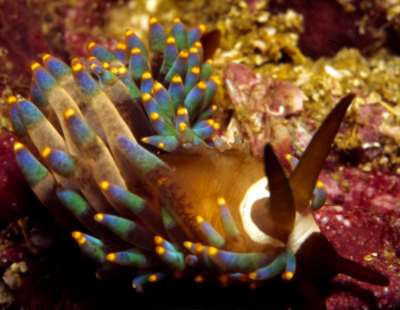
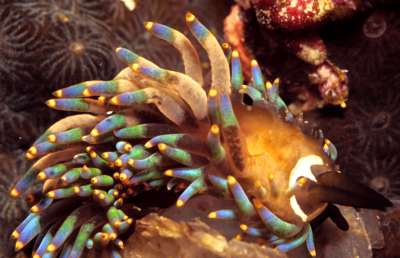
I viewed this in Musandam (Sultanate of Oman) in october 2005, by night. I think it's a Cuthona [H. Debelius called this Cuthona kanga in his book "nudibranch and sea snails "]
Locality: Pearl island, Musandam, Sultanate of Oman. Indian Ocean. Depth: 10 meters. Length: 4 cm. October 2005. Photographer: Laurence Gautier
Please can you give me your opinion.
Thanks Bill.
L. Gautier
laugautier@wanadoo.fr
Gautier, L., 2006 (Feb 8) Cuthona yamasui from Oman. [Message in] Sea Slug Forum. Australian Museum, Sydney. Available from http://www.seaslugforum.net/find/15758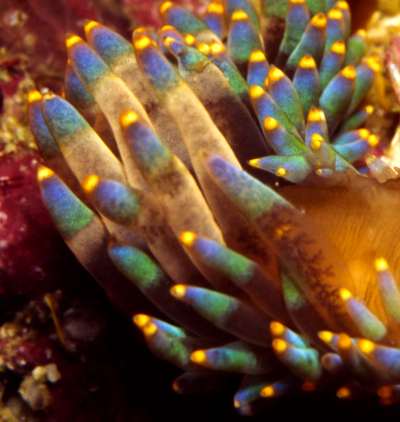
Dear Laurence,
I'm afraid not all colour picture books have correct identifications. I have discussed this identification in an earlier message. It is in fact Cuthona yamasui. Unfortunately Cuthona kanga was described from a single 5 mm long specimen so we can't be sure of its colour varaiation. However the animal was sexually mature suggesting it is a much smaller species than C. yamasui. One major difference is the nature of the ceratal colouration. While there are general similarities in the colour of the cerata, Malcolm Edmund's description of C. kanga clealry states that the blue and green colouration on the cerata were digestive gland colours seen through a transparent ceratal wall. As you can see here, the colours in C. yamasui are pigments on the ceratal skin, and the digestive gland is a finely branched brown duct [see large ceras at right in photo alongside], not a thick solid unbranched structure filling most of the cerata, as described for C. kanga.
Best wishes,
Bill Rudman
Cuthona yamasui from Tioman Island
March 9, 2004
From: Asther M. Lau
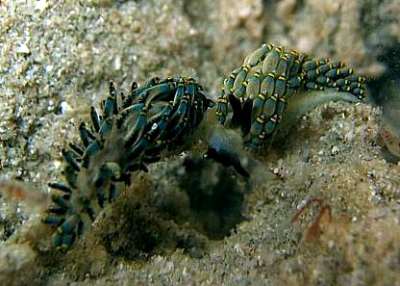
Dear Bill,
Attached is a series of pics I took from one night dive in Tioman Island of a pair of Cuthona kanga getting ready to mate.
The whole process from first pic to last pic took about 8 mins. I didn't take any pics further as my buddies were running low of bottom time.
Site: Salang Wreck, Tioman Island, Malaysia
Date: 17th Oct 2003
Depth: 22 meter
Bottom Contour: Sandy slope
Average size of both: 1 cm
Hope this collection is of useful information for this wonderful site.
Regards,
AML
alau425@hotmail.com
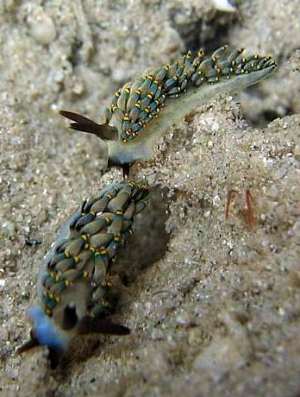
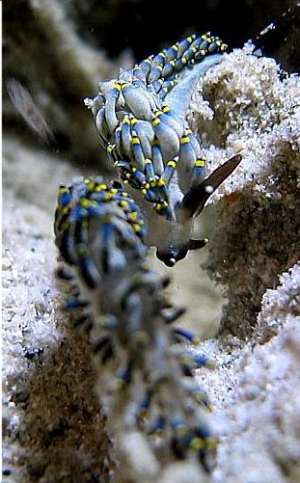
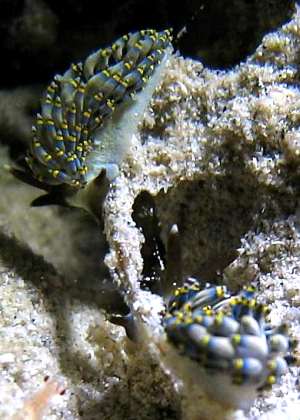
Dear Asther,
Thanks for this interesting observation. We know little about behaviour in most opisthobranchs, but it seems that many seem to be able to follow the mucus trails of their own kind. I say 'seems' because we have little evidence to support such an idea but we often find a pair, like you have, following each other. Mating seems to be a fairly normal response when two animals of the same species meet. I guess when meeting is usually a chance occurrence, it is important to mate whenever the opportunity arises.
This animal is Cuthona yamasui. As I said in an earlier message [#419] this species has been misidentified as Cuthona kanga in some identification guides.
Best wishes
Bill Rudman
Cuthona yamasui mating
September 23, 2003
From: Erwin Köhler
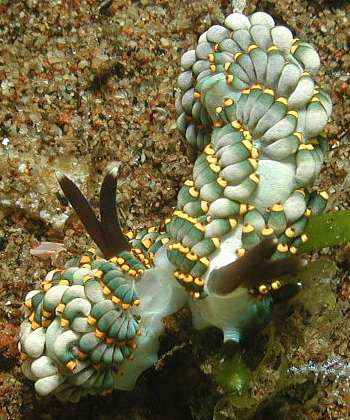
Dear Bill,
Here are a pair of Cuthona yamasui mating. It is from the
Philippines, Negros Oriental island, Lipayo, divesite "El Dorado" housereef.
data:
lengths: 34, 38 mm
depth: 7m
08 May 2003
Regards Erwin
www.Philippine-Sea-Slugs.com
Erwin@Philippine-Sea-Slugs.com
Köhler, E., 2003 (Sep 23) Cuthona yamasui mating. [Message in] Sea Slug Forum. Australian Museum, Sydney. Available from http://www.seaslugforum.net/find/11017Thanks Erwin,
Your photo shows the rhinophores and oral tentacles rather well, and apparently illustrates a colour form without a colour band across the anterior edge of the head.
Best wishes
Bill Rudman
Cuthona yamasui from Indonesia
August 26, 2003
From: Linda Ianniello
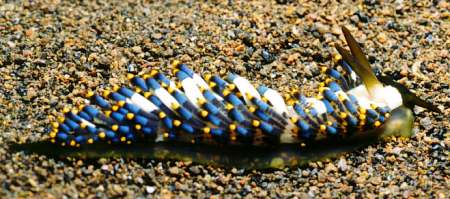
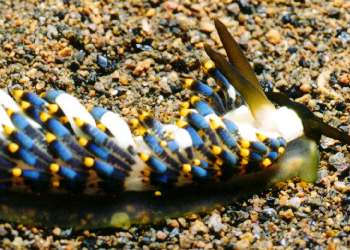
Dr. Bill,
Here is a photo of a Cuthona yamasui from Indonesia to add to the forum. It appears to be regenerating some cerata after some damage to the front of its body.
Date: August, 2003
Dive Site: Black Forest at Sangeang Island
Depth: 40 feet
Length: about 1.5 inches
Regards,
Linda I.
lindai@us.ibm.com
Ianniello, L., 2003 (Aug 26) Cuthona yamasui from Indonesia. [Message in] Sea Slug Forum. Australian Museum, Sydney. Available from http://www.seaslugforum.net/find/10809Thanks Linda,
Bill Rudman
Cuthona yamasui from Borneo
July 11, 2003
From: Makoto Uesugi
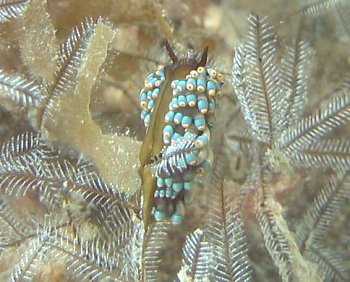
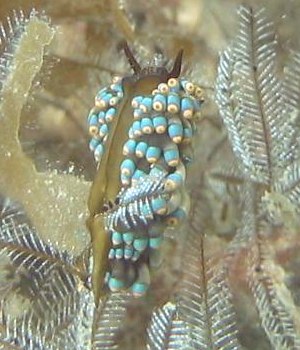
Hello Dr.Rudman,
Nice to meet you. I found this species at Satang Besar Island, NW Borneo.
I think this is a species of Cuthona sp. but, I can’t identify it. Can you help pleas?
Date: 21 May 2003
Location: Satang Besar Island, Sarawak, Malaysia
Depth: 2m
Length: about 3cm
Photo by Makoto Uesugi
Best Regards
Makoto Uesugi
makotoue@tm.net.my
Uesugi, M., 2003 (Jul 11) Cuthona yamasui from Borneo. [Message in] Sea Slug Forum. Australian Museum, Sydney. Available from http://www.seaslugforum.net/find/10294Dear Makoto,
It is nice to get more photos of this species as it is giving us a good idea of it colour variation. It is Cuthona yamasui. This species seems to live only on the stinging hydroid Aglaophenia cupressina, which, from your photo is where you found this animal.
Best wishes,
Bill Rudman
Cuthona yamasui? - colour variation
January 2, 2003
From: Nishina Masayoshi
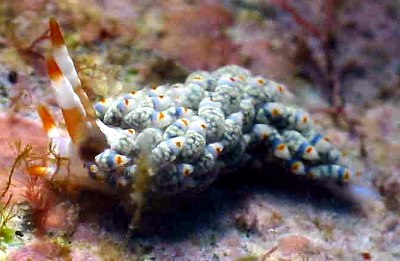
Dear Bill,
Those photos I have attached are rather interesting.
The Upper Image was taken by my colleague Moguricho on 25 Sep. 2002, on Hachijo Island, Japan. size about 12mm. This animal and Scott Johnson's animal look almost the same.
The Lower Images were taken by Yasan on our sea slug site. They were taken on 17 Feb, 2002 on Cebu, Philippines. size about 40mm. I have identified the lower right image as Cuthona yamasui , but it has an unbelievable body color, and it is the puzzle for me.
Best Regards,
Nishina Masayoshi
nishina@wips.co.jp
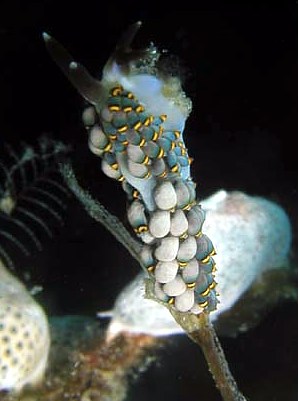
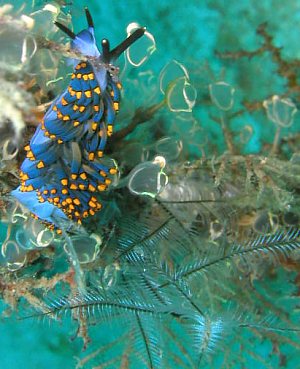
Dear Nishina,
Thanks for these photos which illustrate the range of colour variation which apparently occurs in this species. The hydroid the bright blue animal is on looks quite like the stinging hydroid Aglaophenia on which this species was first reported. It's possible that the animal in your upper photo, and Scott Johnson's, are a different species, but we would need to look at their anatomy
Best wishes,
Bill Rudman
Cuthona yamasui from Sumbawa Is, Indonesia
August 9, 2002
From: Walabha Sinbul
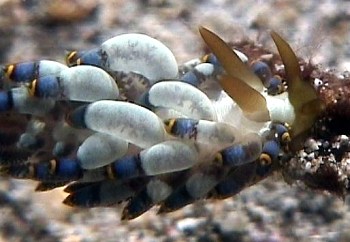
Dear Bill,
Please help with the ID. I just think my find is Spurilla australis.
Dive site: Tunjung Brenti, Sumbawa Island, Indonesia
Depth: 45ft.
Size: 3cm.
Activity: found clinging on Hydroids
Thanks so much.
Walabha
walabha@clickta.com
Sinbul, W., 2002 (Aug 9) Cuthona yamasui from Sumbawa Is, Indonesia. [Message in] Sea Slug Forum. Australian Museum, Sydney. Available from http://www.seaslugforum.net/find/7713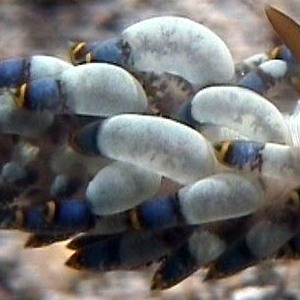
Dear Walabha,
Although this does look a bit like Spurilla australis and has been mistaken for a member of the family Aeolidiidae, it is in fact Cuthona yamasui, a member of the Tergipediidae. Your mention of it 'clinging on hydroids' is a useful clue to identification as species of the Aeolidiidae usually feed on sea anemones and their close relatives, rather than on hydroids.
I have included a closeup of some of the cerata, as they show that the digestive gland duct in each ceras branches. This is a rather interesting feature of this species because such branching is not usual for the Tergipedidae, and in fact I can't think of another species that does so.
best wishes,
Bill Rudman
Cuthona yamasui from Myanmar
May 28, 2002
From: Boo Nilsson
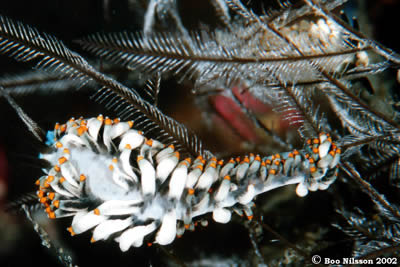
Hi Bill,
Came across these two Flabelina's (?) feeding on a crinoid while diving in the Mergui archipelago in Myanmar earlier this year. Any ideas? Seen at about 7 meters depth, 30mm long.
Cheers,
Boo
boonilsson@cox.net
Nilsson, B., 2002 (May 28) Cuthona yamasui from Myanmar. [Message in] Sea Slug Forum. Australian Museum, Sydney. Available from http://www.seaslugforum.net/find/6927Dear Boo,
Thanks for this photo. I think this is the first nudibranch we have had from Myanmar [Burma]. I am pretty sure it is the species I am calling Cuthona yamasui. The hydroid it is on looks quite like the stinging hydroid Aglaophenia on which ths species was first reported.
Best wishes,
Bill Rudman
Cuthona? from the Marshall Islands
April 12, 2002
From: Scott Johnson
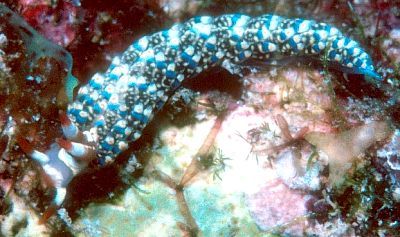
Hi Bill,
Here's a small (about 12mm) animal I have found at both Kwajalein and Enewetak Atolls. Some years ago, I jotted a note on the slide mount that it seemed similar to Cuthona kanga. What do you think?
Scott
johnson@kmr.ll.mit.edu
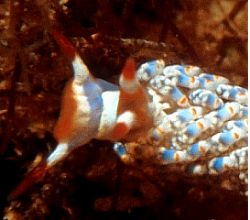
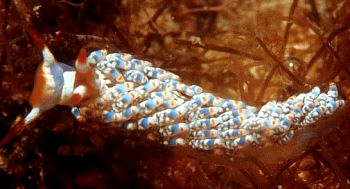
Dear Scott,
I think this is the animal I have recently identified as Cuthona yamasui
Best wishes,
Bill Rudman.
Cuthona kanga? from Tanzania
March 15, 2002
From: Bernard Picton
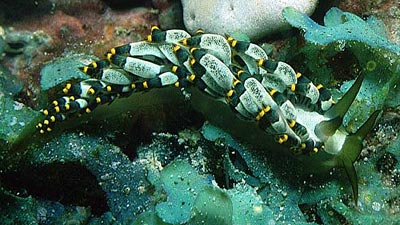
Hi Bill,
I see that you are calling this Cuthona sp 1 on the Forum. Like Erwin I also identified it as Cuthona kanga from Debelius, but on looking at the original description I think you may be right that that is a different species. At least my pictures extend the range of this entity to East Africa. It was on a hydroid which looked like Lytocarpus or Aglaophenia, probably the same one as Erwin's.
Pemba Island, Tanzania - February 1999
Bernard
bernard.picton.um@nics.gov.uk
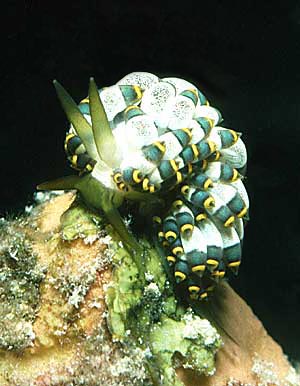
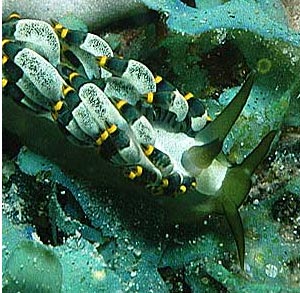
Dear Bernard,
I'm glad you sent these photos as it made me relook at this animal and my notes on it. I think it is a dark form of Cuthona yamasui Hamatani 1993. I think it has an orange and a blue-black colour form, much like Phestilla melanobrachia, though whether the colour change is related to food colour as in Phestilla I wouldn't know.
Interestingly, Hamatani and Erwin Koehler report its food as Aglaophenia and you think yours were on a similar looking hydroid.
Best wishes,
Bill Rudman
Cuthona yamasui from Queensland
March 15, 2002
From: Bill Rudman

Bernard Picton's message with photos of what I have been calling Cuthona sp. 1 made me relook at this species and I am pretty sure that it is Cuthona yamasui. If so, it appears to have two main colour forms, one in which translucent orange dominates and another in which this is replaced by blue-black. Here are photos of the two colour forms from Queensland, Australia.
PHOTO: UPPER: Wonga Beach, N. of Mossman, Queensland, Australia, January 1974. AM C94083. Photo: I. Loch.
LOWER LEFT: Broadhurst Reef, 12-15m, Townsville, Queensland, 18 Nov 1974, AM C96580. Photo: I. Loch.
LOWER RIGHT: SEM Photo of radula of Wonga Beach specimen. Photo: G. Avern.
Bill Rudman


Re: Cuthona sp
January 4, 1999
From: Erwin Koehler
Dear Bill,
I gave the ID "Cuthona kanga" to the photo at the Fragile Ocean site according to H. Debelius' book. Now I've had the time to examine the update list (published in Wayne's AN-News 3), now that ID is changed to Cuthona sp...
Erwin.
E.Koehler@deutschepost.de
Koehler, E., 1999 (Jan 4) Re: Cuthona sp. [Message in] Sea Slug Forum. Australian Museum, Sydney. Available from http://www.seaslugforum.net/find/437Cuthona kanga? from Philippines
December 23, 1998
From: Erwin Koehler
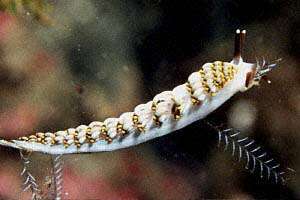
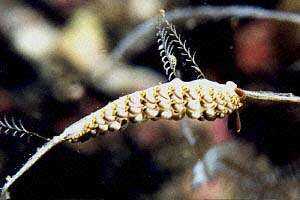
Dear Bill,
Here is the next one from Negros, Philippines (October 1998). The photos were made during a night-dive, there was some current and the hydroid with the slug on it was waving heavily. It took a lot of tries to get some good shots. Size about 1,5 cm, depth 13m. I think it looks a bit like Cuthona kanga.
Erwin
E.Koehler@deutschepost.de
Koehler, E., 1998 (Dec 23) Cuthona kanga? from Philippines. [Message in] Sea Slug Forum. Australian Museum, Sydney. Available from http://www.seaslugforum.net/find/419Dear Erwin,
Your photos certainly look like the species illustrated at the Fragile Ocean site in your Opisthobranchs of the World picture link site, but I don't think that animal is correctly identified.
Cuthona kanga (Edmunds, 1970) was described from Tanzania. It would appear to be a much smaller species (5mm long mature) and coloured rather differently. The body is essentially transparent with three opaque cream longitudinal bands, one dorsal and one on each side. The oral tentacles and rhinophores are colourless with white banding and white marks, not black as in your species. In your species the cerata are opaque white with gold and blue bands which are clearly epithelial colour. In C. kanga the cerata are translucent or transparent with a translucent gold band below the whitish tip. The blue colouration below the gold band is from the colour of the digestive gland duct.
Any other ideas on the identity of this species would be welcome.
Best wishes,
Bill Rudman.
